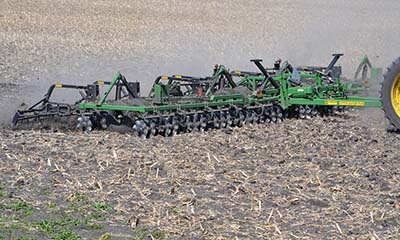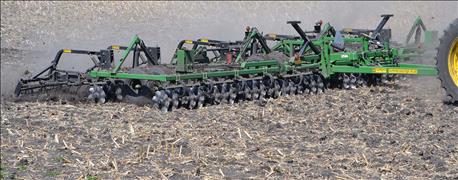September 29, 2015

Vertical tillage equipment started out using coulter blades that were mounted at a zero-degree angle on the frame. Today, there are a lot of so-called vertical tillage tools that look more like disks with angled blades. You need to look at the trend, and choose the right tool to accomplish what you want done in your fields.
Related: Questions to Ask About Vertical Tillage Tools
Since it was first introduced to farmers for use in the field a number of years ago, the term "vertical tillage" has been ingrained in most people's heads. The definition of it, however, remains a bit fuzzy.

VERTICAL TILLAGE: This is a vertical tillage tool. Vertical tillage tools have become more popular in recent years to help manage larger amounts of crop residue, such as in fields where continuous corn is grown.
Anyone who has compared vertical tillage tools recently has likely noticed this: Between the different configurations and blade options available, no two tools seem to be the same.
Of course, this begs the question, "What is vertical tillage, and which unit is right for me?"
What is vertical tillage and what is it designed to do?
According to Summers Manufacturing, one of the first companies to develop and sell vertical tillage tools, vertical tillage is best defined as a tool that enters and exits the soil on a vertical plane.
"In 1999 we developed our Supercoulter with two gangs of coulter blades mounted at a zero-degree angle," says Brian Perkuhn, vice president of sales and marketing for Summers. "It was designed to size residue, naturally fracture the soil, and promote good moisture management and deep root growth. It doesn't move any soil horizontally, so farmers don't experience the same soil smearing and hardpan effects of disking."
The Supercoulter hasn't been the only one to take on the growing trend, though. Timothy Harrigan, a tillage specialist with Michigan State University Extension, has been conducting research with a variety of tools, due to a large number of farmer requests.
"We're hearing a lot of comments from people dealing with heavy amounts of crop residue, especially in high-yielding corn," he says. "They're having difficulties with the residue not breaking down, which is likely the result of today's improved varieties that are resistant to decay from insects and disease," he says.
Dispelling crop residue mangement myths >>
~~~PAGE_BREAK_HERE~~~
Dispelling several of the crop residue management myths
In his trials, Harrigan has noticed some tools offer more aggressive action than others. One of the factors that affect aggressiveness is blade type. VT equipment offered with a variety of blades, including flat, notched, fluted and concave options.
"One way to get more soil action and aggressive tillage is to use a more aggressive coulter, primarily some of the fluted coulters," he says. "There is also the option to use vertical tillage tools that have shell-shaped, concave disks that look like disk blades."
Another factor that makes a big impact on aggressiveness is the gang angle. "Some tools have a zero-degree gang angle with the blades mounted perpendicular to the direction of travel," says Harrigan. "As you increase that gang angle, up to about 18 degrees on some models, you start to get a lot of lateral soil movement."
Some manufacturers now refer to 'true vertical tillage" tools
Due to the wide performance range among VT tools, some manufacturers have made a push recently to create their own sub-category called true vertical tillage.
"On true vertical tillage tools like the Supercoulter, the blades do not move any soil horizontally. We gain soil movement from the wavy blades lofting the soil in to the air based on speed and penetration depth," says Perkuhn. "If the blades don't maintain a straight line of travel through the soil, it's not true vertical tillage."
The definition of VT isn't the only thing that's flexible. In fact, some manufacturers are starting to offer tools that can adjust the amount of soil movement on the go in the field.
Perkuhn says, "As farming practices improved and farmers started dealing with tougher residue, we saw the need for equipment that could offer true vertical tillage performance and also move more soil when needed to bury heavy crop residue in high-yielding areas."
What's ahead for vertical tillage >>
~~~PAGE_BREAK_HERE~~~
You'll see more adjustable vertical tillage tools in years ahead
As a result, farmers can expect to see more adjustable VT equipment in the future. "Variable rate tillage is the next big thing in tillage," says Perkuhn.
Of course, as they become available, these new tools will give farmers even more equipment choices in an already crowded marketplace. "There's really a wide range of options for vertical tillage," says Harrigan.
However, in the end, he believes finding the best tool depends on each farmer's soil type, cropping program and residue management goals. The number of variables makes it difficult for him to provide a strong recommendation for what people should use.
"Selecting a vertical tillage tool is like setting up a no-till planter to meet specific needs," says Harrigan. "Farmers have to understand what they want to accomplish and how the machine's various components are going to play out."
Vertical tillage tools are designed to run fast and shallow, with the goal of cutting down on residue while leveling out the seedbed. Want to know more? Check out our free report 5 Tips You Need To Know About Vertical Tillage, for pointers on deciding if vertical tillage is right for you.
You May Also Like




